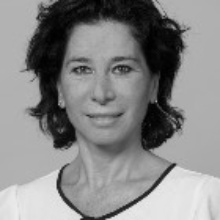Kontakt
Waldburgstraße 17/19
70563 Stuttgart
Deutschland
Fachgebiet
Beteiligt an Teilprojekten, inklusive Position:
B3 – Multimodale datengetriebene Sensorfusion , Teilprojektleiterin
2023
- P. Somers, S. Urich, R. Sauer, J. Schüle, O. Sawodny, and C. Tarín, “Real-Time Software-in-the-Loop Simulation of the OpenAPS System,” in 2023 IEEE/SICE International Symposium on System Integration (SII), Jan. 2023, pp. 1–5. doi: 10.1109/SII55687.2023.10039344.
- P. Somers et al., “Cystoscopic depth estimation using gated adversarial domain adaptation,” Biomedical Engineering Letters, vol. 13, Art. no. 2, May 2023, doi: 10.1007/s13534-023-00261-3.
2022
- P. Somers, J. Schüle, C. Veil, O. Sawodny, and C. Tarín, “Geometric Mapping Evaluation for Real-Time Local Sensor Simulation,” in 2022 44th Annual International Conference of the IEEE Engineering in Medicine & Biology Society (EMBC), Jul. 2022, pp. 609–612. doi: 10.1109/EMBC48229.2022.9871932.
- P. Somers et al., “Growth of Simulated Tumors Under the Influence of Oxygen Supply,” IFAC-PapersOnLine, vol. 55, Art. no. 20, 2022, doi: 10.1016/j.ifacol.2022.09.170.
- J. Schüle, J. Haag, P. Somers, C. Veil, C. Tarín, and O. Sawodny, “A Model-based Simultaneous Localization and Mapping Approach for Deformable Bodies,” in 2022 IEEE/ASME International Conference on Advanced Intelligent Mechatronics (AIM), Jul. 2022, pp. 607–612. doi: 10.1109/AIM52237.2022.9863308.
- C. Veil, O. Makni, P. Somers, J. Schüle, C. Tarín, and O. Sawodny, “Detection Limits of Tetrapolar Impedance Sensors for Tissue Differentiation,” in 2022 44th Annual International Conference of the IEEE Engineering in Medicine & Biology Society (EMBC), Jul. 2022, pp. 1–4. doi: 10.1109/EMBC48229.2022.9871065.
- C. Veil et al., “Electro-Mechanical Coupling in Impedance-Based Tissue Differentiation Under Compression\ast,” IFAC-PapersOnLine, vol. 55, Art. no. 20, 2022, doi: 10.1016/j.ifacol.2022.09.155.
2021
- N. Harland et al., “Organoide zur Weiterentwicklung der intraoperativen Diagnostik,” Der Urologe, vol. 60, Art. no. 9, Sep. 2021, doi: 10.1007/s00120-021-01595-5.
- C. Veil, R. Bach, P. Somers, O. Sawodny, and C. Tarín, “Geometry Factor Determination for Tetrapolar Impedance Sensor Probes,” in 2021 43rd Annual International Conference of the IEEE Engineering in Medicine & Biology Society (EMBC), Nov. 2021, pp. 6800–6805. doi: 10.1109/EMBC46164.2021.9629757.
- J. Schüle et al., “Multi-Physical Tissue Modeling of a Human Urinary Bladder,” in 2021 43rd Annual International Conference of the IEEE Engineering in Medicine & Biology Society (EMBC), Nov. 2021, pp. 4297–4302. doi: 10.1109/EMBC46164.2021.9629482.
- P. Somers, J. Schüle, C. Tarín, and O. Sawodny, “2D to 3D Segmentation: Inclusion of Prior Information using Random Walk Kalman Filters,” in 2021 43rd Annual International Conference of the IEEE Engineering in Medicine & Biology Society (EMBC), Nov. 2021, pp. 4222–4225. doi: 10.1109/EMBC46164.2021.9629734.
Diplomarbeit (1996): „Digitale Video- und Datenübertragung mit Vertikallaserdioden“, Abt. Optoelektronik, Universität Ulm, Betreuer der Diplomarbeit: Prof. K.J Ebeling
Diplomstudiengang Elektrotechnik (1991 – 1995), Hauptstudium mit Vertiefungsrichtung Telekommunikationstechnik und Informationstechnik, Technische Universität Valencia (Universidad Politécnica de Valencia UPV), Spanien, Abschluss: Dipl.-Ing.
Promotion zum Dr.-Ing. (2001): Dissertation mit dem Thema „Trajectory and Position Control of a Nonholonomic Autonomous Mobile Robot“, Abt. Mess-, Regel und Mikrotechnik, Universität Ulm, Prof. Hofer
2009 – heute, Professorin am Institut für Systemdynamik, Universität Stuttgart
2005 – 2009, Gruppenleiterin für Signalverarbeitung, Informationstechnik und Systemdynamik im Bereich Mobile Communications des Instituts für Multimedia-Anwendungen und Telekommunikation an der Technischen Universität Valencia (UPV), Spanien
2003 – 2005: Stipendium der Deutschen Forschungsgemeinschaft
2002 – 2003: Fakultätsdozentin an der Abt. Signal- und Kommunikationstheorie der Universität Carlos III Madrid, Spanien





